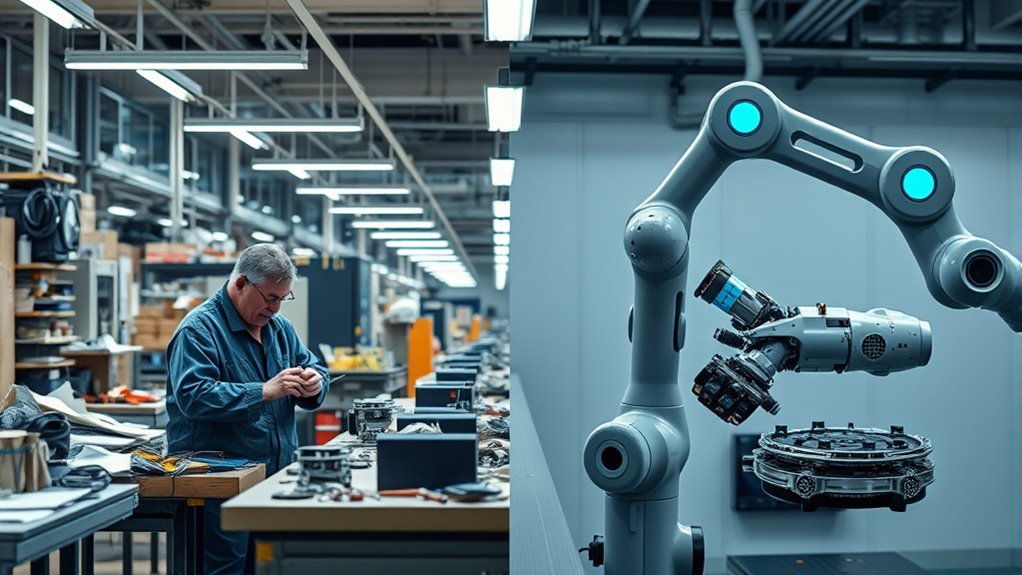Automation is reshaping the job market by removing many middle-skill roles, while expanding high- and low-skill positions. Routine tasks like data entry and bookkeeping are increasingly automated, leading to wage divides and reduced job quality in middle roles. Women and workers in certain regions face higher risks of displacement, especially if they lack reskilling opportunities. Understanding these shifts can help you navigate future career challenges—keep going to learn how industries and policies are responding.
Key Takeaways
- Automation and AI replace routine middle-skill tasks, leading to a decline in traditional middle-wage jobs.
- High-skill roles expand as AI augments cognitive and creative tasks, widening income inequality.
- Low-skill jobs grow due to automation reducing entry barriers, but often with lower wages and stability.
- Job polarization results in a labor market with fewer middle-skill opportunities and more high- and low-skill roles.
- Workers face challenges in reskilling and adapting as middle-skill roles diminish across various industries.
The Shift Toward High-Skill and Low-Skill Employment

As automation increasingly transforms the job market, there’s a clear shift toward high-skill and low-skill employment, while middle-skill jobs decline. You’ll notice high-skill roles grow as AI and automation handle routine tasks, pushing workers into specialized, cognitive, or creative positions that require advanced expertise. Conversely, low-skill jobs often expand because automation reduces barriers for entry or creates new opportunities in sectors like retail, hospitality, and delivery. This polarization means you’re more likely to find either highly complex roles or low-wage, manual jobs, with fewer opportunities in the middle. For workers, this shift demands new skills and adaptability, as traditional middle-skill roles become less available, reshaping career paths and income prospects across the economy. Additionally, Vetted electric bike conversion kits exemplify how technology is transforming traditional industries and opening new avenues for innovation and employment.
Automation’s Impact on Routine Middle-Skill Tasks

Automation has profoundly reshaped routine middle-skill tasks, often replacing manual processes with AI and machine learning. You’ll notice that many repetitive tasks, like data entry, inventory management, and basic bookkeeping, are now handled by machines. This shift increases efficiency and reduces costs but also means workers in these roles face job displacement. For example, bookkeeping jobs declined by a third between 1980 and 2018 as automation took over routine tasks, though remaining work became more specialized and better paid. Inventory clerks saw employment double, yet wages dropped due to an increased labor supply and lower skill requirements. AI tools augment tasks for roles like budget analysts, maintaining employment but changing the nature of their work. Overall, automation targets routine middle-skill tasks, transforming job roles and skill demands. The rise of specialized dog breeds like the Black Golden Retriever and Golden Dachshunds reflects how certain traits and skills are valued and cultivated in specific roles.
Wage Polarization and Job Quality Changes

Wage polarization occurs when automation and technological shifts cause wages to diverge sharply between different types of jobs. As routine middle-skill roles decline, wages in these positions tend to fall, reflecting reduced skill requirements and job quality. Conversely, high-skill jobs that leverage AI and automation often see wage increases, as demand for specialized expertise grows. This dynamic widens income gaps and deepens economic inequality, especially for workers in vulnerable sectors. Low-skill jobs that are less automatable may see modest wage growth or stagnation, but often lack the stability and benefits of higher-tier roles. Overall, automation is reshaping not just employment patterns but also the quality and fairness of wages across the labor market, creating a more polarized economic landscape. Additionally, the decline of middle-skill jobs impacts career development opportunities, making it harder for workers to progress within their fields.
Gender Disparities in Automation Risks

You should recognize that women face a higher risk of automation displacement, with 79% of employed women in the U.S. working in roles vulnerable to AI. This disparity deepens existing gender wage gaps, as women are often concentrated in middle-skill jobs at greater automation risk. While automation bias can reinforce these inequalities if algorithms are not transparent, inclusive design has the potential to reduce gender-based hiring biases.
Women at Higher Risk
Why do women face a higher risk of job disruption from automation? You might notice that women are often overrepresented in roles vulnerable to automation, especially those involving routine or repetitive tasks. For example, women make up a large share of clerical, administrative, and customer service jobs, which are highly susceptible to AI and robotic process automation. Additionally, societal expectations and occupational segregation mean women are more likely to work in sectors where automation is advancing rapidly. As technology replaces routine tasks, these roles shrink or transform, putting women at greater risk of displacement. Furthermore, limited access to reskilling opportunities can hinder their ability to transition into emerging, less automated roles, further deepening their vulnerability in a rapidly changing labor market. Regularly assessing and organizing their skills and resources can help women adapt more effectively to these shifts.
Gender Wage Gaps
Gender wage gaps are widening in the face of automation, as women often earn less than men even before technological disruptions accelerate. Automation disproportionately impacts female-dominated middle-skill jobs, which tend to pay less and face higher risks of displacement. As routine tasks become automated, many women in these roles see wages stagnate or decline further, deepening economic inequality. Women are also overrepresented in high-risk sectors like clerical work and customer service, where automation reduces job security and pay. Meanwhile, high-skill roles that remain less vulnerable tend to be male-dominated and better paid. This divergence worsens existing gender disparities, making it harder for women to catch up economically. Without targeted policies, automation will continue to entrench gender-based wage gaps and economic inequalities.
Automation Bias Concerns
Automation bias can deepen gender disparities as organizations increasingly rely on algorithms to make hiring, promotion, and task allocation decisions. If these algorithms aren’t designed inclusively or lack transparency, they may reinforce existing biases, favoring one gender over another. Women, already underrepresented in high-risk automation jobs, might face further marginalization if automated systems unintentionally prioritize traits or experiences more common among men. For example, hiring algorithms trained on historical data could perpetuate gender stereotypes, reducing chances for women to advance. Additionally, biased task assignments could limit women’s opportunities to develop new skills, trapping them in lower-paid or more vulnerable roles. Without careful oversight, automation bias risks amplifying gender inequalities, making it even harder for women to access equitable job growth amid rapid technological change. Emphasizing attention and oversight in the development and deployment of these systems is crucial to mitigate these risks.
Regional Variations in Job Automation Exposure

Regional variations in job automation exposure are significant, reflecting differences in economic development, industry composition, and technological adoption. In advanced economies, higher automation risks target routine middle-skill jobs, especially in finance, manufacturing, and administrative sectors. Conversely, low-income regions face lower exposure due to less automation capacity and different industry focuses. Here’s what you should consider:
- North America and Europe experience high automation in finance and professional services.
- Asia-Pacific leads in manufacturing automation, impacting factory and warehouse roles.
- Low-income countries see fewer jobs at risk, but face challenges in adopting automation technology.
- Urban areas tend to have higher exposure than rural regions, driven by industry concentration and infrastructure.
- Ongoing development of AI safety measures is crucial to ensuring responsible deployment of automation technologies across regions.
Understanding these differences helps tailor policies to manage regional impacts effectively.
Challenges in Workforce Reskilling and Education

You need to address the fast pace of skill obsolescence caused by automation, which makes current education systems struggle to keep up. As technology evolves, workers must continuously learn new skills, but access to effective reskilling programs isn’t always equitable. Ensuring everyone can adapt requires targeted policies that provide fair and widespread opportunities for lifelong learning. Incorporating vetted product reviews can help identify reliable educational resources and tools to support this ongoing skill development.
Rapid Skill Obsolescence Risks
As technology rapidly advances, workers face increasing risks of skill obsolescence, making continuous reskilling essential but challenging. You must stay ahead to avoid falling behind as automation replaces routines. Here are key challenges:
- Rapid pace of change means skills become outdated faster, often within a few years.
- Limited access to affordable, relevant training hampers workforce adaptation.
- Employers may lack the resources or willingness to invest in ongoing employee development.
- Disparities in education and digital literacy widen the gap, leaving vulnerable groups at higher risk.
- Incorporating training and meal prep strategies into daily routines can help workers develop new skills more effectively.
Without proactive efforts, many workers will struggle to keep their skills current, risking unemployment or underemployment. Steering through this shifting landscape requires resilience, agility, and support systems that facilitate continuous learning.
Education System Adaptation
Adapting the education system to meet workforce reskilling needs presents significant challenges, as rapid technological change demands continuous learning and new skill acquisition. You must design curricula that keep pace with evolving industry demands, integrating digital literacy, technical skills, and soft skills. Traditional education often lags behind labor market shifts, leaving learners unprepared for new roles. You need flexible pathways—such as modular courses and online programs—that enable workers to upskill quickly. Collaboration between educational institutions, employers, and policymakers is essential to create relevant training programs. Ensuring that reskilling is accessible to all, regardless of socioeconomic background, remains a key challenge. Without proactive adaptation, the education system risks widening gaps and leaving many workers behind in the face of automation-driven job polarization. Additionally, embracing innovative learning environments like hackathons can foster practical skills development and stimulate creative problem-solving among learners.
Equitable Reskilling Access
Ensuring equitable access to reskilling opportunities remains a significant challenge as automation accelerates workforce transformation. You need to address barriers that prevent many workers from gaining new skills. Consider these key issues:
- Limited digital infrastructure in underserved communities hampers access to online training.
- Cost barriers prevent low-income workers from affordable reskilling programs.
- Lack of tailored training options leaves some workers unprepared for high-skill roles.
- Systemic biases in education and hiring processes restrict opportunities for marginalized groups.
- The availability of affordable, high-quality training resources directly influences the effectiveness of reskilling efforts.
To create a fairer system, you must focus on expanding digital access, subsidizing training costs, developing inclusive curricula, and ensuring policies promote equal opportunity. Only then can reskilling serve as a true pathway to economic security for all workers.
Strategies for Policy and Business Adaptation

Effective policy and business strategies are essential to steering the rapid changes brought by automation and AI. You should focus on promoting upskilling initiatives that help workers adapt to evolving job requirements, emphasizing digital literacy and technical skills. Encourage businesses to invest in reskilling programs, fostering a culture of continuous learning to retain talent and reduce displacement. Implement inclusive hiring practices and guarantee equitable access to training, particularly for women and vulnerable populations at higher automation risk. Policymakers must develop social safety nets, such as wage subsidies or transition support, to cushion workers during shifts. Collaboration between government, industry, and educational institutions is crucial to create adaptable workforce ecosystems that meet future labor market demands and mitigate inequality.
Frequently Asked Questions
How Will Automation Affect Job Satisfaction Across Different Sectors?
Automation will likely impact your job satisfaction differently across sectors. In routine roles, automation can reduce boredom by automating repetitive tasks, boosting satisfaction. However, if automation leads to job displacement or increased pressure to adapt quickly, it might decrease satisfaction. In high-skill sectors, automation can enhance your productivity and creativity, improving fulfillment. Ultimately, your experience depends on how your sector adopts automation and your ability to upskill.
What Role Do Small Businesses Play in Automation-Driven Job Polarization?
Small businesses play a vital role in automation-driven job polarization. They adopt automation to stay competitive, which often leads to replacing routine middle-skill jobs with machines. This shift can create new high-skill roles but also displaces many workers, especially in local communities. By embracing automation, small businesses can boost productivity, reduce costs, and innovate, but they must also support workers through upskilling and reskilling efforts to navigate these changes.
Are There Specific Industries More Resistant to Middle-Skill Job Decline?
Certain industries resist middle-skill job decline because they rely on tasks that automation can’t easily replace. You’ll find healthcare, education, and creative fields like arts and media more resistant, as they depend on interpersonal skills, critical thinking, and creativity. These sectors require complex human interactions and nuanced decision-making, making them less vulnerable to automation. If you work in or plan to enter these industries, your job faces lower risk of displacement from automation.
How Does Automation Influence Remote Work Opportunities and Work Flexibility?
Automation can boost remote work opportunities and work flexibility by streamlining repetitive tasks and improving digital collaboration tools. You’ll find it easier to work from anywhere, as automation reduces the need for physical presence and manual processes. This shift allows you to focus on higher-value tasks, promotes flexible schedules, and increases access to remote roles across various industries. Embracing automation helps you adapt to new work environments with greater ease and efficiency.
What Ethical Considerations Arise From Ai-Driven Hiring and Workplace Automation?
You must consider the ethics of AI-driven hiring and workplace automation carefully. It’s essential to guarantee transparency, so candidates understand how decisions are made. You should prevent biases from algorithms, which can reinforce discrimination, especially against women or minorities. Protecting privacy is critical, as automation often involves sensitive data. Ultimately, you need to promote fairness by providing equal opportunities and avoiding unfair job displacement, fostering trust and inclusivity in your workplace.
Conclusion
As you navigate this shifting job landscape, remember that change is the only constant. Automation may be hollowing out middle-skill roles, but with proactive reskilling and smart policies, you can stay ahead of the curve. Don’t let this challenge catch you off guard—embrace the opportunity to adapt and grow. Keep your eyes open and your skills sharp, because when the going gets tough, the tough get going.









